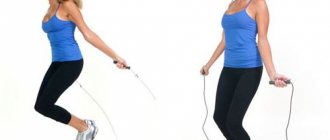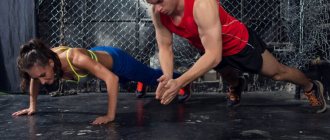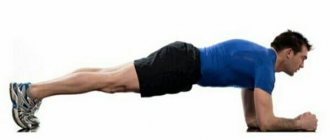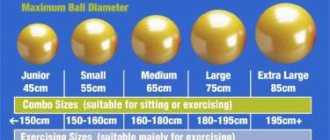Jumping rope technique
The technique of basic jumping rope is very simple. Hold the rope at hip or waist level with your palms facing your body. Begin each jump with a slight bend in the knees, and all jumps should be performed using the ball of the foot. When jumping rope, your back should be straight and your abdominal muscles tense. Try not to jump high, 2–4 cm is the optimal height for intense training.
Alternate jumps. Follow the same rules as for basic jumps, but stand on one leg, changing legs with each jump. Alternate jumping on one leg and then on the other leg is one of the most popular techniques for exercising with a skipping rope to develop coordination.
Combination jumping rope. This is a combination of basic jumps with alternate jumps. Combination jumps look like this: jump on two legs, jump on the left leg, on two, on the right, on two, etc.
High jumping is a high-intensity jumping rope technique similar to alternate jumping jacks. The difference is that when your right foot touches the ground, lift your left knee as high as possible, and so on, alternating legs. Essentially these are the same alternate jumps only with high knees.
15-Minute Interval Cardio with Jump Rope
- 1 minute: slow pace – Basic jumps (warm-up)
- 2 minutes: moderate pace - Basic jumps
- 2 minutes: moderate pace - Alternate jumps
- 2 minutes: fast pace – Combination jumps
- 3 minutes: moderate pace - Basic jumps
- 2 minutes: moderate pace – high jumps
- 2 minutes: fast pace – Basic jumps
- 1 minute: slow pace – Basic jumps (cooling down)
Advanced Rope Exercise Scheme (500 Jumps)
After every 50 jumps, change the jump rope exercise
- Basic jumps – Feet together.
- Side Jumps – Place your feet together and jump from side to side.
- Basic jumps – feet shoulder-width apart.
- Cross Jumps – As you jump, change the position of your legs and feet. Legs crossed - feet shoulder-width apart, etc.
- Alternate jumps.
- High jumps.
- Combination jumps.
- Jumping with crossed arms - Feet together.
- Basic jumps – 100 times.
Jumping rope helps burn subcutaneous fat, lose weight, improve agility, coordination and endurance. In addition to the obvious benefits, jumping rope can be fun as you can always practice different tricks and jumping techniques to improve your skills.
Jump rope training
How to learn to use a jump rope to jump like a professional boxer. What exercises with a skipping rope are most effective and what are their benefits?
It will not be easy for a beginning athlete to master exercises with a skipping rope, but the acquired skill will remain for many years. In order to understand what exemplary work with a jump rope looks like, you should look at the training of professional boxers. An inexperienced person will not be able to repeat the exercises for a boxer; first you need to learn how to jump very quickly and do it for a long time.
The playful ease and success of boxers in working with a skipping rope is the result of constant loads and long-term exercises. Visitors to the boxing section always develop diversified; a trained boxer can demonstrate success in other sports.
Before moving on to jumping rope techniques for professional athletes, it is important to master the basic principles of working with a jump rope, they are the basis of everything.
Even if you are not focused on achieving professional success in boxing, working with a jump rope will help you get in good shape and improve your health.
How should you jump rope?
Recommendations from experts for those who want to improve their health with the help of a jump rope:
The main advantage of a jump rope is the availability of this simulator both in the gym and at home. Boxing trainers know most about jumping rope, and they will be able to evaluate the results more objectively than anyone else.
Different techniques for jumping rope
To understand how to do everything correctly on YouTube, it is important to familiarize yourself with different jumping techniques. Easy jump How to learn to jump rope from a video for children? Open the material with a slight jump. It's the simplest
You just need to jump, guided by the basic rules - jump in front of the rope with a pushing motion, practically without straining your legs. Alternate jumps How to learn to jump rope from a video? You need to alternate legs. The point is that less energy is wasted and the jumper can stay in motion longer. You will have to practice here, since it is not always possible to immediately understand with your body and muscles how to learn to jump rope (video) using this technique. Criss-cross Criss-cross is the most common technique, but you need to cross your arms in front of your body. Make clear movements, cross in front of your body in a way that is comfortable for your height. How a child can learn to jump rope using this method can be learned from the video.
How to properly jump rope with a cross will be clear to those who have developed hands. Try stretching your fingers and muscles in your free time - this will help develop sensitivity. How to learn to jump rope with a cross will become clear over time, a couple of days after training (many people start jumping right away). Side swingDouble jumps
Double scroll
Complex technology. How to learn to double jump on a skipping rope? You need to train for a long time using the techniques described above. How can boxers learn to jump rope using technique and is it realistic? Really. Some people practice quintuple scrolling. Of course, you should start with double.
Make sure your arms accelerate faster than your legs. Use your feet to gently push off the floor, landing on most of your foot. Push off slowly, rolling your foot. When you are above the ground, you need to make more turns with the rope. You can make this whole process smooth, but it takes practice. How to jump rope correctly for boxers? Start by double scrolling once every few times. This frequency will make the task easier for a beginner.
How to jump rope correctly for boxers: video
Study the video material, pay attention to every detail. Make sure your legs are straight
This is one of the main problems of boxers
Remember, it is important to balance the speed. You can figure out how to properly jump rope as a boxer in a few minutes of training.
The video will help you decide at what time intervals you need to carry out certain movements
Using the boxing technique, you can figure out how to learn to jump rope in 1 day. Over time, you will understand that jumping is a simple process, and the muscles can be taught to do it automatically, without thinking about subsequent actions. You will also understand how to learn to jump rope for a long time. Training and time are the key to everything. Breathing is important - inhale through your nose, exhale through your mouth.
Why do Boxers Jump Rope?
For as little as $5, you won't find a cheaper, more effective piece of boxing training equipment (except maybe for gravity). This is one of the most effective and fun ways to improve your boxing performance! If you're not jumping rope, you're missing out on one of the best exercises for fighters.
Advantages of jumping rope for fighters:
- better endurance
- better footwork
- increased striking power
- increased stamina for landing combos
- improved breathing efficiency
- improved ability to remain calm
Jumping rope will improve your: physical condition, rhythm, coordination, footwork and strength.
Jumping rope is one of the best training discoveries I have made in any sport. I used to come to the gym, work on the mitts, work on the bag, and then immediately move on to sparring. I never took the time to jump rope.
It was time-consuming, it wasn't fun (at first), and I never saw the point in it. And on top of that, my first coach didn’t force me to jump rope. It's just shocking that many sports don't include jumping rope as a standard exercise. I can only assume that this is probably because jumping rope is difficult to learn at first and is confusing even for seasoned athletes.
All professionals jump rope
I only started jumping rope after I started wanting to copy the professionals. They did this for warm up and cool down and I figured I could do at least a few rounds every day. The results after a month were simply amazing. I felt like an idiot for not starting to do this sooner.
Best Footwork
This is the most obvious benefit, and it makes sense. For most new fighters, the only leg work they do is 75% running and about 25% plyometrics, weights, or non-running exercises. The problem is that all of these exercises don't actually develop a better "coordinated lower body."
Good footwork has more to do with leg coordination than physical leg conditioning.
You might think that running is really good for developing your legs, but it's not. Many fighters have their head in the clouds when they run, or throw their legs out at random. Even the most dedicated runners hardly do anything difficult with their feet other than making sure their foot lands on the ground. Plyometric exercises, weights, and other resistance exercises have the same problem. These are boring, repetitive movements and do little to activate your sensation in your feet. At best, you will have better leg conditioning, but you will still have no control over your lower body.
This is where the jump rope comes in handy. Jumping rope FORCE you to be more conscious of your feet. And the more tricks you do on the jump rope, the more attentive and coordinated you need to be. Developing coordination certainly leads to better footwork in the ring. Being able to control your feet will make a bigger difference than simply lifting your feet and throwing them everywhere.
More Stamina
Jump rope is definitely my number one endurance exercise for boxing. It's better than running, it's better than swimming, it's better than CrossFit, it's better than anything else I've ever tried. And now I will tell you why...
The first reason is that a jump rope can copy many exercises. You can run, you can sprint, you can jump high, you can jump low, squats, jerks, crunches, turns, etc. You can make virtually unlimited body movements while jumping rope. Add in the fact that you can vary the intensity, speed, difficulty, rhythm, etc., and you have the perfect exercise.
The second reason (which is more important than the first) is that jumping rope WILL DEVELOP BETTER PRODUCTIVITY. This is a technical question, not a physiological one. Jump rope forces you to do a lot of repetitive movements over and over again, and also with a good rhythm (or else you will trip over the rope). This quickly develops muscle memory, coordination and superior technique.
I don't care how good a sprint program or a weight training program might be. If I were to compare a boxer who jumps rope for 10 minutes every day with a boxer who lifts weights for 30 minutes every day, the one who jumps rope would easily outperform him every time. He will have more balance, more control and more agility on his feet.
I know this because I developed my shuttle through jumping rope. Running developed my endurance well, but jumping rope really taught me how to be productive in the shuttle. With a jump rope, I could easily jump over 100 times a minute, so naturally I quickly learned to jump in the most productive manner possible. This is such a fundamental skill, yet so many fighters STILL don't know how to work the shuttle for an entire round without their legs getting tired. I'm not saying you should shuttle all the time, but it is important to be able to move without getting tired!
More Rhythm
Jump rope is an incredibly useful exercise for training for fights because it imitates the rhythm of a fight better than other exercises. You are forced to be in constant motion and always maintain attention. The problem with fighters who don't jump rope is that they aren't used to being in constant motion and don't have constant attention span. They slowly move from stillness to movement.
Jumping rope always improves your mental focus. You don't "sleep" in fights anymore because you're used to always being aware of something (like the cable). In the ring, this increased mental focus helps you avoid incoming punches or find opportunities to counter. At the very least, your improved focus helps you keep your mind calm so you don't panic during sudden exchanges. Fighters who jump rope are better at maintaining a consistent rhythm (physically and mentally) even when they are not actively moving.
More Power
This may come as a surprise to some, but jumping rope actually increases your punching power. As I said earlier, when you jump rope, your body is forced to make many repetitive movements quickly and in rhythm, so your body naturally learns to move productively. This same skill will transfer to the way you hit.
And the jump rope increases not only the power of your blow, but also the power of your movements. You will be much more powerful in every movement because you are now a more productive and more coordinated machine. Generally speaking, I can look at fighters in the ring and tell who is jumping rope and who is not. Once you learn to jump rope yourself, you will be able to see what I am talking about. There is a difference between fighters with a naturally relaxed shuttle and a shuttle that wastes muscle energy.
Jumping rope for weight loss exercises
There are a large number of jump rope exercises that help not only lose weight, but also get your cardiovascular system in order. However, most often, jumping rope is used to lose weight in the legs, because such exercise at home has a significant effect on the hips, stomach and arms.
Let's look at the 18 most effective exercises in order of increasing difficulty:
- Simple jumps - jump on two legs over the rope;
- Alternately on each leg;
- Jumping rope sideways;
- Back and forth with every revolution;
- With legs crossed;
- With legs crossed without an intermediate position;
- Spreading your legs to the sides;
- Run in place, raising your knees up;
- Run in place, raising your heels up;
- From toes to heels;
- Jump with your arms crossed;
- Rotate your hips in different directions;
- On the heels (not recommended for those with back problems);
- Alternately placing one leg forward;
- Bounce on one leg for 10 rotations;
- With a double turn of the rope;
- With reverse rotation;
- Run forward.
After the first workouts, you will feel which muscles work most actively, as they will hurt the next day. You will immediately feel that jumping rope for losing weight on your legs is indispensable, as your thighs and calves work at full capacity. The arms, back and stomach are also involved, which contributes to figure correction.
If the exercises we gave are not enough for you, then watch this video where jumping rope turns into a dance.
How many calories are burned when jumping rope?
Do you know how many calories jumping rope burns?
- 5 minutes of jumping rope will save you 50-70 kilocalories - this is equivalent to 10 minutes of swimming;
- 1 hour of jumping will allow you to get rid of 500-800 kilocalories - 3 hours on a bicycle;
- 100 jumps will take only 1-2 minutes, and will cost 20-40 kcal;
- 1000 jumps will save you from 80-120 kcal;
Jumping rope records
- Ashrita Furman - jumped 130,000 in 24 hours;
- Robert Commerce - 425 jumps in 1 minute;
- Tori Boggs - 984 times in 3 minutes;
- Julien Kempener - 168 times in 30 seconds;
- Albert Reiner - 128 times in 10 seconds;
- Martin Leuner – 111 double jumps in 1 minute;
- Dr. Jean Skorkowski - 23,344 times in 2 hours and 33,956 times in 3 hours;
- Frank Oliveri - jumped 31 hours 46 minutes and 48 seconds without stopping;
There are more than 3 dozen more records in various variations. However, it is not the achievements that should become an example, but the figures of the jumpers. Just look what these athletes look like. This is the best proof that jumping rope is useful not only for weight loss.
https://youtu.be/UkIEMYPmSjU
Jump rope in boxing. Boxing rope! No boxer's training is complete without a jump rope.
Popular materials
Today's:
Jump rope in boxing. Boxing rope! No boxer's training is complete without a jump rope.
A jump rope is a necessary training attribute that develops endurance and strengthens the cardiovascular system.
Working with a jump rope, first of all, affects the blow, since the force of a punch in boxing depends on the overall stability of the body, and also develops the endurance of the calf muscles and ease of movement. A lot of merit can be attributed to working with a jump rope, so it’s not for nothing that all boxers pay special attention to this.
Jumping rope involves a creative approach. It is very reasonable to practice jumping rope to music, which can set the rhythm of the movements and work out the beat. You can change the rules of movement, come up with your own in accordance with the change in the beat of the music. You can try “Walking” by jumping. For example, set a goal to reach some object as a result of jumping - standing in the opposite corner of the simulator, and move slowly and tactfully by jumping. To make jumps varied and not get boring, you should diversify your technique.
1. improve heart function, saturate the blood with oxygen and stabilize blood circulation; 2. burn subcutaneous fat;. 3. regulate cholesterol levels;. 4. strengthen bone tissue;. 5. lift your spirits; 6. improve coordination of movements;. 7. develop jumping ability; 8. ten minutes of working with a skipping rope is equivalent to thirty minutes of running; 9. develop the boxer’s ability for technical improvisation during a fight; 10. trains explosive strength.
How to choose the right jump rope.
First of all, you need to choose the right length of the rope. To do this, you need to take the handles in your hands, stand with your feet in the middle of the rope, and pull the rope so that the handles are at the highest possible level. The ideal length of a rope is considered to be one that, when stretched, reaches the level of the armpits and chest. The rope should not be too long, otherwise it will get tangled. Also, it should not be too short, otherwise it will hit your legs and hit your head when rotating. When jumping with such a rope, you will have to constantly bend down so that it does not touch anything, since relaxation during jumping is out of the question.
The jump rope and its role in the training of famous boxers.
All boxers attach a significant role to jumping rope, this cannot be neglected. The jump rope is present in the “diet” of every boxer’s training, and the first world celebrities understood the use of such a simple and effective exercise.
A jump rope is a very simple and extremely useful exercise machine. Before such a warm-up, you should not eat in the last three hours, otherwise it will be difficult to jump.
The jump rope is an excellent training tool for a boxer.
When doing jumping rope, you need to clear your head, think about something pleasant, relax and surrender to the rhythm. After a few minutes, the body itself will dance to the beat of your favorite music. Do not gently apply force to the rotation of the rope; it will rotate by inertia at a suitable speed, except for accelerated jumps, of course, and double jumps. Jumping rope is very simple, and most importantly, very useful.
Boxing jump rope Vasily Lomachenko. Vasily Lomachenko launched a challenge with a jump rope: a video has appeared
WBA lightweight world champion Vasily Lomachenko launched a new sports challenge with a jump rope
The athlete did fifty jump ropes in just twenty seconds, and after that he challenged boxers Alexander Usik, Roy Jones and UFC fighter TJ Dillashaw, writes znaj.ua.
“Sometimes it is very important to take the first step to start something. I want as many people in the world as possible to play sports, so I’m launching a 20-second challenge on Instagram,” Vasily Lomachenko wrote on his page.
“Thank you, but it didn’t happen the way I wanted. Golovkin lost the fight and I just moved up. I do not like it. I want to earn my first place. I want to be the absolute world champion. I want to unify the titles and I want to own all four titles,” Lomachenko said.
At the same time, the athlete noted that if it weren’t for boxing, he would have become a wrestler, since he really likes it. Lomachenko also suggested that he could become a football player, gymnast, dancer, but his favorite sport after boxing is wrestling.
At the same time, the Ukrainian WBA world lightweight champion Vasily Lomachenko received the status of WBA super champion. This title will allow the Ukrainian to compete for the WBA championship in any weight category.
The WBA also decided to compete for the belt between Jorge Linares and Daoud Jordan. The athletes should hold negotiations in the near future.
Let us add that Lomachenko came to the defense of Alexander Usik. The fact is that some Ukrainians bombarded Usik with criticism for his fight on Russian territory. Therefore, Vasily Lomachenko decided to stand up for his friend, who won his title in Moscow following the results of his fight with Russian Murat Gassiev.
Politeka also reported that Schwarzenegger visited Lomachenko in the hospital: unique footage.
What is a jump rope for in boxing? Jump rope training
Great things are created from small things. It would seem that a jump rope is a very simple equipment, but what a huge foundation for the skill and physical training of a boxer is created by working with it.
Indeed, along with learning the basics of boxing: striking mechanics, movement, transferring body weight and general physical fitness, it is necessary to master the jump rope. Training on this apparatus allows you to improve coordination and develop explosive leg strength.
Pay attention to how professionals work with a skipping rope. For example, Roy Jones jumps on his toes, slightly lifting himself off the floor. Shoulders are relaxed, hands are actively working. At the same time, the boxer performs various, including complex, movements. It is important that the jump is as low and explosive as possible. This short pulse from the feet will give power and sharpness to your strikes. The shorter the movement, the more explosive power it contains. It is advisable to work with the rope in this manner.
And don't be lazy. Jump rope training should be included in every workout. For example, Konstantin Tszyu spent up to 5 hours a week jumping during training.
Benefit
In addition to developing boxing-specific coordination skills, explosive strength, the ability to relax and improvise, jumping rope significantly improves the functioning of the heart muscle and strengthens bone tissue. While jumping rope, the deltoids, triceps, trapezius, back muscles, buttocks, thighs and calf muscles are pumped. In all respects, this equipment is useful for any athlete. Moreover, a jump rope costs from 150 to 1000 rubles.
The most inexpensive ones are made of plastic, while more expensive samples are made of leather and equipped with wooden handles. It is recommended to immediately purchase professional equipment made of genuine leather, because you will have to work a lot with the jump rope. We wish you good training. For motivation, we suggest watching training videos of legendary boxers.
This video contains a whole collection of jump rope workouts - from Muhammad Ali, Sugar Ray Robinson, Joe Louis to Manny Pacquiao and Floyd Mayweather. Each boxer, like the style in the ring, has his own style of working on this apparatus. Sonny Liston - overweight, squatting Roberto Duran, explosive Mike Tyson and others:
Manny Pacquiao jumps on his toes with minimal separation from the floor, placing his right foot slightly forward:
Mohammed Ali's jump rope workout:
Jumping Vasily Lomachenko:
Benefits of jump rope in boxing. Rope exercises for a boxer. What's the benefit?
For everyone who trains in the boxing section in Moscow, endurance, punching power and good footwork are important. An interesting fact is that exercises with only one equipment help to achieve this: a jump rope. Let's talk about this in more detail.
Result
Often, athletes attending training sessions at the club neglect one simple exercise: jumping rope. They believe that this is a waste of time and prefer to just run or even go to the gym. A boxer needs strong legs so he can move quickly around the ring. And you need stamina to survive the battle to the end. But jumping ability and agility are also important in order to not only jump back in time, but also dodge the blow.
All famous boxers begin their training with this apparatus; it is for them instead of a warm-up. And beginning athletes attending a boxing school in Moscow should listen to the opinion of their coach and be sure to perform jumping ropes. This way they will be able to increase their endurance, because they can diversify this exercise and make it interesting. For example, jumping on one leg or two, fast and slow, high and low, etc.
If you go to class and jump rope for only 10 minutes a day before training, you can improve your technique. The muscles will remember every movement and this will come in handy during a fight, when you need to bounce off a blow. By the way, the ability to bounce back from a blow in time and not get tired at the same time needs to be learned; it is not inherent to everyone.
By regularly performing this exercise, the boxer becomes more attentive, resilient, he does not panic and does not waste his energy. At the same time, he learns to look closely at something all the time, which means he will be less distracted in the ring.
Exercises for weight loss
Jumps when using a jump rope are divided into different categories according to the difficulty of execution, taking into account the person’s training, his skills and capabilities. I will introduce you to some of them:
Single jumps on both legs are a classic jumping option. One rotation of the rope and jump on both legs. The jumping speed can be gradually increased. The faster the jumping pace, the faster the calories are burned.
Alternate jumps are very easy to perform. You must jump alternately with your right and then with your left foot; from the outside it looks like running in place, only with a jump rope. This exercise develops movement coordination and burns calories.
Criss-cross jumps are basic and are especially revered among boxers. First, a normal jump is made, and then, the arms are crossed at the level of the elbows, while the rope cord is above the head and another jump is made.
The cross exercise has another modification when arm movements (crossing) are performed behind the back. This is a more difficult exercise.
Jumping with high knees. The exercise itself is simple, similar to classic alternate jumps, only you need to raise your legs high in this exercise, bending them at the knees. Exercise requires a lot of energy.
For other types of exercises, watch the video: 26 exercises on a skipping rope.
What are the contraindications for jumping?
- Jumping, like any physical exercise, has both indications and contraindications.
- It is not recommended to jump for people with sore joints: arthritis and arthrosis.
- Bone and spinal diseases.
- For constant migraines and even rare headaches.
- With increased blood pressure, myocardial infarction, stroke, vascular diseases.
- Overweight, or rather obesity, is also a contraindication. You need to calculate your body mass index to know whether your weight is normal or overweight.
- It is not recommended to exercise on a full stomach. About 2 hours should pass after eating.
Jumping itself puts stress on the blood vessels and even increases blood pressure. Therefore, it is better for people suffering from these diseases to consult a doctor.
Jumping rope is an accessible and enjoyable form of exercise that improves well-being and health. Jumping equipment is not expensive, and you can practice this sport anywhere and at any time.
Read further: Rejuvenation with Tibetan hormonal gymnastics
Be healthy, dear readers!
Blog articles use pictures from open Internet sources. If you suddenly see your author's photo, inform the blog editor about it through the Feedback form. The photo will be deleted or a link to your resource will be provided. Thanks for understanding!
What does physical training develop?
https://youtu.be/osvMMLTuLHY
Video: Physical training of a drummer
To do this, it is important to regularly visit the gym, since strength exercises develop stamina, endurance, striking power and performance in a fighter. Good general physical shape is an undoubted advantage over an opponent in terms of strength.
During training, it does not matter which muscle groups you train, the whole body must be trained in boxing.
The main task
As a rule, in general physical training there is no sparring; here the main task is to develop your body and spirit. Despite this, basic physical activity is aerobic in nature.
Such physical activities include:
- run;
- abdominal exercises;
- jumping rope;
- training hand endurance;
- work on apparatus, exercises on uneven bars and horizontal bar.
There are several basic exercises that significantly improve a fighter’s overall physical fitness.
General physical exercises for the development of a boxer
Skipping training program for 30 days
Experts say that when jumping rope, fat deposits begin to be burned after half an hour of intense jumping. Depending on the problem, an individual training program for weight loss is developed.
Class schedule for the first two weeks
The first 1-2 weeks of exercise should be light. Jumps are performed every other day, alternating with rest 1:1. Approximate sequence:
- 10 minutes of basic jumps;
- bending with a rope back and forth, to the sides (at least 3 minutes each);
- 10-minute reverse jumps;
- exercises for the abs;
- alternate jumps for 5 minutes on each leg.
Class schedule for 3-4 weeks of training
During this period, jumping should prevail over intermediate exercises. Sample training program:
- 15-minute basic jumps;
- exercises to tighten the muscles of the legs and buttocks (10-15 min.);
- 10-minute double jumps;
- abdominal exercises (10-15 min.);
- 15-minute single jumps.
The average person cannot perform more than 100 jumps/minute. This indicator should be your guide.
Monthly skipping program for weight loss based on the number of jumps/day
How does jumping affect the body?
Marina: I've been skipping for a month. I jump every evening, devoting half an hour of time to the activity, and in total I perform about 1,500 jumps. Did jumping rope help me lose weight? During this time, I lost 3 kg without denying myself my favorite foods. After 3 weeks of training, the volume of the hips decreased by 5 cm, the body became toned and slimmer.
Photos of Marina before and after a month-long skipping lesson
Ksenia: Two months ago I decided to jump rope, the reviews about these exercises are only positive. I worked out regularly, doing 2000 jumps per day. The body tightened, the sides became smaller.
Photos of Ksenia before and after skipping lessons
Photos of Ksenia before and after skipping lessons
Jumping rope
Category: Burn fat, Training Published March 26, 2012
Believe it or not, jumping rope is a very effective exercise for losing weight and burning fat! Jumping rope allows you to get an intense cardio workout in no time.
As you know, interval cardio is the best cardio workout for losing weight and burning fat. Therefore, the optimal jump rope workout should be jumping, which involves short periods of high intensity. The effectiveness of the exercises will be even greater if you use some form of resistance (such as ankle weights or dumbbells), but this is not necessary.
Jumping rope presents you with a huge selection of exercises and training options. Jumping rope is a full-body exercise that keeps your arms and legs in shape, engages your abdominal muscles, improves coordination and overall muscular endurance. Jumping rope workouts are also great for improving your cardiovascular system.
Just 15 minutes of intense jump rope exercise will give you an effective full-body cardio workout! Let's look at a few different techniques and methods that will allow you to perform jumping rope in a more intense manner...
Jumping rope technique
Basic Jumping Rope – The technique of basic jumping rope is very simple. Hold the rope at hip or waist level with your palms facing your body. Begin each jump with a slight bend in the knees, and all jumps should be performed using the ball of the foot. When jumping rope, your back should be straight and your abdominal muscles tense. Try not to jump high, 2 – 4 cm is the optimal height for intense training.
Alternating Jumps – Follow the same rules as basic jumps, but stand on one leg, changing legs with each jump. Alternate jumping on one leg and then on the other leg is one of the most popular techniques for exercising with a skipping rope to develop coordination.
Combination jumping rope - This is a combination of basic jumps with alternating jumps. Combination jumps look like this: jump on two legs, jump on the left leg, on two, on the right, on two, etc.
High jumping is a high-intensity jumping rope technique similar to alternate jumping jacks. The difference is that when your right foot touches the ground, lift your left knee as high as possible, and so on, alternating legs. Essentially these are the same alternate jumps only with high knees.
15-Minute Interval Cardio Workout with Jump Rope
- 1 minute: slow pace – Basic jumps (warm-up)
- 2 minutes: moderate pace - Basic jumps
- 2 minutes: moderate pace - Alternate jumps
- 2 minutes: fast pace – Combination jumps
- 3 minutes: moderate pace - Basic jumps
- 2 minutes: moderate pace – high jumps
- 2 minutes: fast pace – Basic jumps
- 1 minute: slow pace – Basic jumps (cooling down)
Advanced Rope Exercise Scheme (500 Jumps)
Every 50 jumps, change the jump rope exercise
- Basic jumps – Feet together.
- Side Jumps – Place your feet together and jump from side to side.
- Basic jumps – feet shoulder-width apart.
- Cross Jumps – As you jump, change the position of your legs and feet. Legs crossed - feet shoulder-width apart, etc.
- Alternate jumps.
- High jumps
- Combination jumps
- Jumping with crossed arms - Feet together.
- Basic jumps – 100 times.
Jumping rope - conclusion
Jumping rope helps burn subcutaneous fat, lose weight, improve agility, coordination and endurance. In addition to the obvious benefits, jumping rope can be fun as you can always practice different tricks and jumping techniques to improve your skills.
Jumping rope exercises are a very effective means of achieving fitness results, but to achieve the best progress, you must surprise your body and introduce variety. Therefore, take into account other fat-burning training schemes, for example, a 15-minute fat-burning workout at home or interval training with dumbbells. However, in addition to cardio exercises, for high-quality body structure and fat burning, strength training is also necessary; in more detail, strength training and weight loss.
Program to improve physical performance
Video: Physical training in professional boxing
What follows is a generally accepted program aimed at developing the fighter’s physical fitness. Using such a program, a boxer will be able to improve his physical performance before direct training, using a punching bag, bag, sparring, etc.
- Warm up. Simple running at intervals of 10-15 minutes, alternately rotating your arms forward and backward for several minutes, bending over and touching your toes in a sitting position, as well as turning your torso to the right and left with your arms extended to the sides.
- Push ups. It is recommended to do push-ups on your fists from 20 to 50 times and do 2 to 5 approaches.
- Pull-ups. It is recommended to do pull-ups on the horizontal bar 10 to 15 times and do 2 to 5 approaches, alternating grips.
- Jumping rope. Jumping rope is considered more effective. It is recommended to do them for 10-20 minutes, alternating the difficulty of the jumps. After completing the exercise, you can rest for a few minutes.
- Exercises with dumbbells. It is recommended to curl your arms with dumbbells, alternating their different weights (on average, 5 sets of 30 to 60 seconds of work are used, taking a one-minute break between sets).
- Leg lift. It is recommended to raise your legs to an angle of 45 degrees when lying down. It is important to hold your legs in this position for 30-60 seconds, no more than 5 approaches.
- Squats. It is recommended to do squats for 50 repetitions, no more than 5 sets.
- Exercises for training the neck. While lying on your back, you need to raise your head, making circular movements and up and down movements.
- Exercises with a barbell. It is recommended to clench your elbows while holding the barbell for an average of 10 to 15 repetitions, up to 5 sets.
Preparation for jumping
Before training with a jump rope, you should decide on the following points:
- Training location
- Dress
- Type of sports equipment.
We will look at each of them separately further.
Requirements for the place of study
You can jump at home too. But you need to take into account that in a small room it will be difficult to make jumps with such a wide scope. You will need an area of approximately 1x2 meters with a free space of about 2.5 meters in height. And if you live in an apartment, then the creaking of the ceiling may upset the neighbors below a little.
Ideally, the floor should be covered with a fairly soft and slightly springy material. For example, a rubber fitness mat. Although, of course, the most elementary thing is to go outside and jump on the platform in front of the house. Of course, the best option is a gym.
What to wear?
Wear shoes that will support your ankle
For training you will need sportswear. A close-fitting uniform made of thin, breathable fabrics is recommended so that the movements are free when jumping, but there is no hindrance during revolutions.
Girls are advised to wear a sports bra. As for footwear, a great choice would be lightweight sneakers with soft ankle support, which provides fairly good lateral stability. Why is this necessary? For joints on which the load will be applied more evenly, so there will be less chance of injury.
Choosing a jump rope
There are 4 main types:
| Weighted | Such jump ropes differ from others in that they have noticeable weight. They are not that easy to use, especially for untrained people. When jumping on such a rope, the body muscles are loaded more than usual, which will help increase their volume. |
| Express | Ideal for burning fat. They allow you to make an unimaginable number of jumps per unit of time. If you want to lose weight as quickly as possible, then you should use a high-speed jump rope for this purpose. |
| Electronic with calorie burn counter | You just need to weigh yourself and then enter your parameters into the counter. And then the “smart” device will independently calculate the exact number of calories burned. Such jump ropes can also be weighted or high-speed. The cost of electronic “weight loss tools” is much higher. |
| Plain with rubber torso | You've probably seen this look in physical education classes at school. They are the most common and inexpensive. They are also suitable for weight loss and cope with this task quite effectively. |
As for the length, standard jump ropes are 2.4 m, 2.70 m, 3.00 m. If you don’t know what length you need, you can use the following guide: for a person with a height of 1 meter 65 centimeters, it’s ideal A jump rope 2.4 meters long is suitable. When choosing a jump rope, you can do this: take it by both handles, stand straight, straighten your back completely and place your foot on the hanging rope. Start lifting the rope up. If you managed to bring the handles to the level of your armpits, then this is the length that suits you.
Don't be afraid to guess wrong with this parameter. It is better to take a rope a little longer, because they all have special hands that allow you to change the size of the rope downward.
Recommendations for beginners with a jump rope
This article will talk about how to use a jump rope for beginners. An exemplary example of jump rope work includes every boxing workout. However, in order to learn how to jump rope like a boxer, you first need to learn how to jump at an increased pace over a long period of time.
Boxers easily demonstrate various tricks, thanks to regular exercise that helps achieve this result. In general, the boxing section provides a versatile base for training athletes. Therefore, instead of looking at the jumping technique of boxers, the basic principles of working with a skipping rope will be described for beginner athletes, or those who want to improve their physical fitness.
General recommendations on how to properly use a jump rope to improve your overall health:
First of all, you need to decide which type of jump rope is best for you. The option of using a jump rope, in which the rope is attached at an angle of 90 degrees, allows for smooth and very fast turns. On the other hand, there are heavier leather jump ropes that rotate more slowly and are harder to work with due to greater air resistance than in the case of a thin plastic rope.
How to choose the right jump rope size
To measure the length of a jump rope in relation to your body size, simply stand on the rope in the middle of the rope, grab the handles and pull them along your body. The handles should be in the area from the hip to the armpit. Larger jump ropes can spin a little slower and require more effort, while shorter ropes can spin faster and more easily.
Find a rhythm
The biggest obstacle for beginners to jump rope is getting the rhythm right, especially when the exercise has been practiced for a long period of time. At first, it is worth paying attention to the jumping technique rather than to the speed or duration of the approach.
Don't worry if you don't get the exercise right the first time, only regular practice will improve your technique and make it easier to use the machine. Do not forget that over time, ordinary jumps will simply be boring, so with the advent of experience, it is worthwhile to diversify the position of the legs, alternating the left and right feet, practice jumping from the heel to the toe of the foot, add crossing the arms, in which the synchronous work of the arms and legs is honed .
Jumping rope for weight loss
Short, 15-minute workouts will increase your endurance and provide moderate stress to your body. If you want to lose weight, then you should alternate them with 30-minute exercises. At the same time, it is advisable to jump as quickly as possible during such training.
Here you should already think about purchasing a high-speed jump rope. It will not give room for imagination and will allow you to perform only standard jumps, but at the same time it will force you to do it at a very fast pace, thanks to which the effectiveness of such a half-hour workout will be equal to a three-kilometer run.
And, of course, do not forget to limit yourself in high-calorie foods. Otherwise, you will become stronger and more resilient, but at the same time, maintain the same volumes.
Types of jumps
A jump rope is a seemingly simple object. It seems, twist the rope, and jump for your health. That's all. But there are quite a few types of jumps. Some of them are easy, some are hard. Learning the different types of jumps may seem difficult, but with diligent practice, you can master them all.
The most common and easiest types of jumps:
- The main leap is the simplest technique. The jumper stands on his feet and, rotating the rope, jumps over it. There's nothing fancy here.
- You can diversify your jumps using the criss-cross technique. This is when every second jump the arms change places, forming a cross.
- There is a technique - alternate jumping with legs. In this case, the person simply runs in place and jumps over the rope with each step.
- Along with other types of jumps, jumpers often perform a technique called a double jump. In this case, they jump higher than usual and perform a double rotation of the rope.
How to choose a jump rope for training
If you decide to start jumping rope to lose weight or train your heart, then it’s time to think about which jump rope to choose? The fitness equipment market offers a large selection of jump ropes with different functionality.
1) Simple jump ropes
This is the most ordinary jump rope that has been familiar to us since childhood. There will be no additional functions or features here. The price of such a jump rope is quite small, so it is suitable for those who still have doubts about purchasing a jump rope or for those who just want to jump “without any hassles.”
The material used to make the cord and handle of a jump rope can be completely different. And its price will largely depend on this. Some jump ropes come with an adjustable length, which is especially important if you are purchasing a jump rope for the whole family.
2) Jump ropes with built-in counter
These jump ropes have a special counter built into the handles, which counts the number of rotations, and therefore the number of jumps made. Jump ropes with a built-in counter are incredibly convenient for tracking progress in exercise and recording results.
You will know exactly how many jumps you have made. You don't need to set a stopwatch or count the number of jumps manually, all data will be recorded. There are also jump ropes with an electronic counter, which can additionally display the duration of the jumping session and the number of calories burned.
3) Speed jumping ropes
But this type of jump rope is ideal for losing weight. Due to the high rotation speed, you will make more revolutions, which means you will train even more effectively. When performing exercises with a high-speed rope, professionals can reach a rotation speed of up to 5-6 revolutions per second! The length of such jump ropes is usually adjustable.
Speed jumping ropes are not suitable for performing complex exercises (jumps with crossed arms, double jumps, etc.). But such jump ropes will appeal to those who like to engage in intense training. By the way, jumping with speed ropes is very popular in CrossFit, and this says a lot.
4) Weighted jump ropes
And another improved version of this fitness equipment is a weighted jump rope. The weight of such jump ropes will be significantly higher compared to other analogues. The jump rope is made heavier by adding weight to the handles or to the weight of the cord. The weight of such jump ropes can even reach three kilograms. In some models, the weight can be adjusted by the practitioner himself.
Weighted jump ropes are more suitable for experienced practitioners who do not have enough load with a regular jump rope. And also for those who want to additionally load the muscles of the upper body.
5) Leather jump ropes
In a leather jump rope, the cord is made of leather. What is special about such jump ropes? By reducing the weight of the cord and increasing the weight of the handle, a specific load is placed on the muscles of the upper body.
When the jump rope cord is light in weight, it rotates more slowly. Therefore, to increase the rotation speed, more effort has to be applied. In this case, the main load falls on the shoulder girdle. Such jump ropes are popular even among professional athletes, for example, among boxers.
Correct Rope for Boxing
Boxing Jump Rope Review
https://youtu.be/6WJ3GoL0FvQ
Check out my review of the different types of jump ropes and find out which ones to buy and which ones to avoid.
Plastic Speed Jump Rope with Plastic Handles attached to the rope at an angle of 90 degrees - THE BEST OPTION
This is the ideal jump rope for boxing training. The thin cable, attached to the handles at a 90 degree angle, rotates easily and is ideal for a typical boxing rhythm. The thin plastic handles are easy to hold, allowing you to concentrate on the line and performing tricks.
The 90 degree angle allows the cable to rotate more easily, avoid twisting, and the length is also easy to adjust. The rope itself gives you the perfect amount of resistance (not too little, not too much) which helps develop coordination and rhythm.
These jump ropes are usually purchased online because they are not available in regular stores. You can purchase the same ones I use (called “The Boxer's Training Jump Rope”, link below):
Plastic Licorice Jump Rope WITHOUT 90 degree angle - 2nd best option
This is usually the cheapest and most common option at sporting goods stores. They are absolutely perfect for boxing and are a pretty good buy at only $5. The problem with these jump ropes is that they don't spin as easily or last as long because the cable doesn't attach 90 degrees to the handles. You'll be able to perform all the basic tricks, but double jumps will require a little more effort.
With increased use and speed, the cable will eventually break the plastic handles at the very top. For a beginner jumping rope, this will most likely happen in a couple of months. For an experienced jumper, this can happen in the first week.
These jump ropes are commonly called "Speed Jump Ropes" and cost about $5.99 at your local sporting goods store.
PVC (polyvinyl chloride) jump rope - bad, terrible rhythm
The most obvious PVC jump ropes are those with black cable and black padded handles. They even have ball bearings, which are supposed to rotate the cable more evenly, but in reality they become a hassle when you want to change the length of the cable.
The main problem with PVC jump ropes is that the rope stretches when you spin it at fast speeds, which can easily throw off your rhythm. Sometimes the rubber jump rope will feel too light and it will be difficult for you to get the rhythm right. You'll see what I mean if you try jumping on one.
Skin is bad, slow and hurts
I especially HATE HATE HATE thick leather jump ropes with wooden handles. I don't know why they sell them because they are terrible and useless. My main complaint is that they spin too slowly and also hit you really hard when you get knocked down. One workout with a leather jump rope and your back will look like you've been whipped, like in the Middle Ages.
Other jump ropes to watch out for
Expensive jump ropes - yes, $40 jump ropes spin fast, but that's overkill for boxing. These jump ropes are designed for performing quadruple rotations and truly spectacular tricks.
Beaded jump ropes - These types of jump ropes are okay, but they require too much energy to spin in my opinion. They are good for outdoor use because the plastic protects the cable.
Steel (or metal) jump ropes – My gripe with metal jump ropes is that they spin too easily. They are too easy to spin and too fast for beginners. With such jump ropes, it is more difficult for beginners to learn the rhythm. Another disadvantage is that metal jump ropes do not stretch like plastic ones, so they do not provide sufficient stress to the arms. Such jump ropes are more suitable for those rets who do tricks, who like to do triple or quadruple jumps. You'll need to compare to see what I mean.
Thick Jump Ropes – By and large, thick jump ropes will always take longer to spin because they require more energy. You may not notice it with single jumps, but double jumps will be much more difficult, if not impossible, for beginners. Use thinner ropes so you can develop better coordination through fast spins.
Thick Handles – I avoid jump ropes with thick handles because you end up focusing more on the handle than the rope itself. The lightweight plastic handles allow you to hold the rope confidently and comfortably with a relaxed hand, so you don't have to focus on "holding" the handles. (This is better for learning tricks.) It is also better when the resistance comes from the cable rather than from the weight of the handles. (This makes it easier for you to feel the rope and develop a jumping rhythm.)
Weighted Jump Ropes – A lot of guys try to add weight thinking it will increase arm speed, but I disagree. Weighted jump ropes distract you from the best qualities of a jump rope—developing coordination and rhythm. Adding weight turns this exercise into a basic conditioning exercise and prevents you from developing high-level coordination.
If you want a more challenging jump rope workout, increase the speed and difficulty of the tricks, not the weight.
The correct length for a jump rope
If you step on the middle of the rope with one foot, its handles should reach your armpits. If you have long arms, you might want to make it a little shorter. Beginners typically start with a slightly longer rope so they don't stumble as easily. As you get better, you can make the cable shorter so it spins faster, allowing you to do more advanced tricks and jump at a faster pace. With time and experience, you will find the ideal rope length for you, with which it is easy and stress-free for you to maintain a constant rhythm.
You should also find a good surface to jump on. The floor should be strong, but slightly springy. Softer than concrete, harder than the canvas of the ring. Hard rubber surfaces, which are usually found in halls, should be suitable. Hardwood flooring will work too. You will get pain in the periosteum around your shin if you jump on a surface that is too hard (concrete) or too soft (carpet). Do not use the jump rope outside because the hard ground will tear the rope.
Now that we're energized, excited, and ready to get started...let's get to the jumping!
Training Options
In fact, there are many options for how you can create a workout if you have a jump rope. There are different options for jumping, which have an equally good effect on the body. Next, each type and its characteristics will be highlighted.
The first type of jumps is classic. So, everyone jumped in childhood and jumps now. The rope rotates, and the person must simply jump over it at the moment when it appears under his feet.
The second type is jumping with steps. This option is considered the most lightweight because it does not require much effort. As a rule, step jumps are performed at an average pace and are intended as a warm-up.
The third type is inverse. They are performed exactly like the classic ones, but the rope rotates backward, not forward. Used by those who have the necessary experience in classical jumping.
The fourth type is with double scrolling. This jumping option is considered one of the most difficult. It is used, as a rule, by professional athletes or those who are in good athletic shape. It is not recommended for beginners, as there is a risk of injury.
Type five - cross-shaped jumps. Such jumps are considered one of the most difficult, along with double twisting.
It is worth paying attention to them, because they should not be performed without special training.











